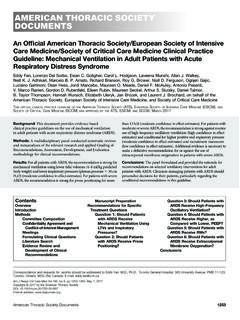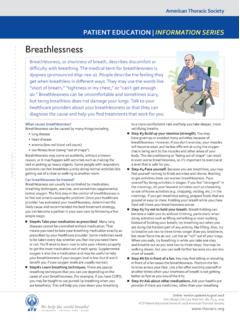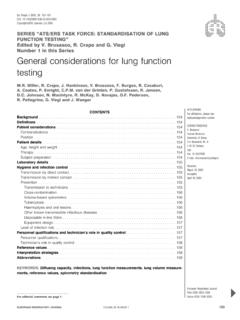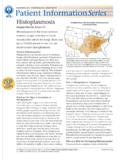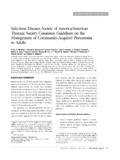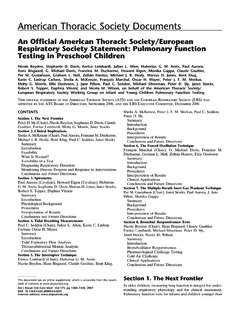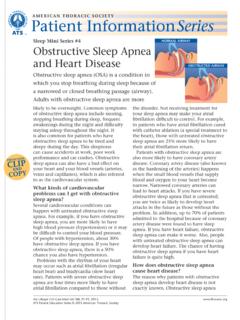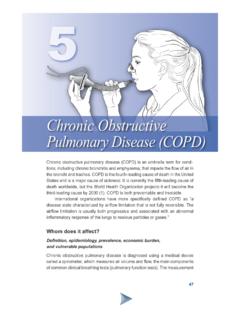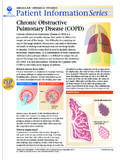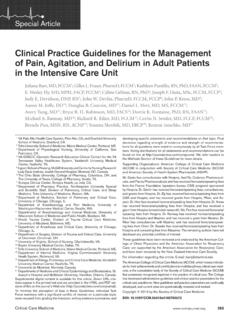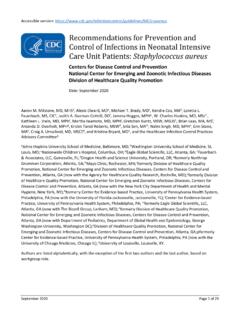Transcription of AMERICAN THORACIC SOCIETY DOCUMENTS
1 AMERICAN THORACIC SOCIETYDOCUMENTSAn Official AMERICAN THORACIC SOCIETY /European SOCIETY of IntensiveCare medicine / SOCIETY of Critical care medicine Clinical PracticeGuideline: Mechanical Ventilation in Adult Patients with AcuteRespiratory Distress SyndromeEddy Fan, Lorenzo Del Sorbo, Ewan C. Goligher, Carol L. Hodgson, Laveena Munshi, Allan J. Walkey,Neill K. J. Adhikari, Marcelo B. P. Amato, Richard Branson, Roy G. Brower, Niall D. Ferguson, Ognjen Gajic,Luciano Gattinoni, Dean Hess, Jordi Mancebo, Maureen O. Meade, Daniel F. McAuley, Antonio Pesenti,V.
2 Marco Ranieri, Gordon D. Rubenfeld, Eileen Rubin, Maureen Seckel, Arthur S. Slutsky, Daniel Talmor,B. Taylor Thompson, Hannah Wunsch, Elizabeth Uleryk, Jan Brozek, and Laurent J. Brochard; on behalf of theAmerican THORACIC SOCIETY , European SOCIETY of intensive care medicine , and SOCIETY of Critical care MedicineTHIS OFFICIAL CLINICAL PRACTICE GUIDELINE OF THEAMERICANTHORACICSOCIETY(ATS), EUROPEANSOCIETY OFINTENSIVECAREMEDICINE(ESICM),ANDSOCIET Y OFCRITICALCAREMEDICINE(SCCM)WAS APPROVED BY THEATS, ESICM,ANDSCCM, MARCH2017 Background:This document provides evidence-basedclinical practice guidelines on the use of mechanical ventilationin adult patients with acute respiratory distress syndrome (ARDS).
3 Methods:A multidisciplinary panel conducted systematic reviewsand metaanalyses of the relevant research and applied Grading ofRecommendations, Assessment, Development, and Evaluationmethodology for clinical :For all patients with ARDS, the recommendation is strong formechanical ventilation using lower tidal volumes (4 8ml/kgpredictedbody weight) and lower inspiratory pressures (plateau pressure,30 cmH2O) (moderate confidence in effect estimates). For patients with severeARDS, the recommendation is strong for prone positioning for morethan 12 h/d (moderate confidence in effect estimates).
4 For patients withmoderate or severe ARDS, the recommendation is strong against routineuse of high-frequency oscillatory ventilation (high confidence in effectestimates) and conditional for higher positive end-expiratory pressure(moderate confidence in effect estimates) and recruitment maneuvers(low confidence in effect estimates). Additional evidence is necessary tomake a definitive recommendation for or against the use ofextracorporeal membrane oxygenation in patients with severe :The panel formulated and provided the rationale forrecommendations on selected ventilatory interventions for adultpatients with ARDS.
5 Clinicians managing patients with ARDS shouldpersonalize decisions for their patients, particularly regarding theconditional recommendations in this CompositionConfidentiality Agreement andConflict-of-Interest ManagementMeetingsFormulating Clinical QuestionsLiterature SearchEvidence Review andDevelopment of ClinicalRecommendationsManuscript PreparationRecommendations for SpecificTreatment QuestionsQuestion 1: Should Patientswith ARDS ReceiveMechanical Ventilation UsingLTVs and InspiratoryPressures?Question 2: Should Patientswith ARDS Receive PronePositioning?
6 Question 3: Should Patients withARDS Receive High-FrequencyOscillatory Ventilation?Question 4: Should Patients withARDS Receive Higher, asCompared with Lower, PEEP?Question 5: Should Patients withARDS Receive RMs?Question 6: Should Patients withARDS Receive ExtracorporealMembrane Oxygenation?ConclusionsCorrespondence and requests for reprints should be addressed to Eddy Fan, , , Toronto General Hospital, 585 University Avenue, PMB 11-123,Toronto, Ontario, M5G 2N2 Canada. E-mail: J Respir Crit care Med Vol 195, Iss 9, pp 1253 1263, May 1, 2017 Copyright 2017 by the AMERICAN THORACIC SocietyDOI: address: THORACIC SOCIETY Documents1253 OverviewThe purpose of this guideline is to analyzeevidence on the use of ventilatory strategiesand associated cointerventions in adultpatients with acute respiratory distresssyndrome (ARDS) and to providetreatment recommendations on the basisof these interventions.
7 For eachrecommendation, it is important toconsider the quality of the evidence reviewsand patient values and preferences beforeapplying these recommendationsto specificclinicalsituationsorpolicy decisions. No guideline orrecommendations can take into account allthe compelling and unique clinical featuresof individual patients, and thereforeclinicians, patients, policy makers, andother stakeholders should not regard theserecommendations as mandatory. Finally,although there may be good reasons toextrapolate these treatments to other causesof acute hypoxemic respiratory failure orto all mechanically ventilated patients, weexclusively reviewed data on patients withARDS, and recommendations therefore applyonly to this group of patients.
8 A summary ofour recommendations is as follows:1. The recommendationsforthe followinginterventions for the treatment of ARDSare strong:a. Mechanical ventilation using lowertidal volumes (4 8 ml/kg predictedbody weight) and lower inspiratorypressures (plateau pressure,30 cmH2O) (moderate confidence in effectestimates)b. Prone positioning for more than12 h/d in severe ARDS (moderateconfidence in effect estimates)2. The recommendationagainstthefollowing intervention for the treatmentof ARDS is strong:a. Routine use of high-frequencyoscillatory ventilation in patientswith moderate or severe ARDS (highconfidence in effect estimates)3.
9 The recommendationforthe followinginterventions for the treatment of ARDSis conditional:a. Higher positive end-expiratorypressure in patients with moderate orsevere ARDS (moderate confidencein effect estimates)b. Recruitment maneuvers in patientswith moderate or severe ARDS (lowconfidence in effect estimates)4. Additional evidence is necessary tomake a definitive recommendationfororagainstthe use of extracorporealmembrane oxygenation in patients withsevere regarding some modes ofmechanical ventilation ( , airway pressurerelease ventilation) and complementarypharmacologic interventions ( ,neuromuscular blockade) were notaddressed because of resource questions are deferred to a futureversion of the is a life-threatening form ofrespiratory failurecharacterized byinflammatory pulmonary edema resultingin severe hypoxemia (1).
10 The severity ofARDS is classifiedaccordingtothedegree of hypoxemia (PaO2/FIO2ratio),with mutually exclusive categories ofmild (PaO2/FIO2,201 300), moderate(PaO2/FIO2,101 200), and severe(PaO2/FIO2<100) (2). ARDS is common,is associated with substantial morbidity,is frequently fatal, and represents animportant public health problem (3 5).Despite decades of research, there arelimited therapeutic options directed at theunderlying pathological processes (6), andsupportive care with mechanical ventilationremains the cornerstone of patientmanagement (7).
